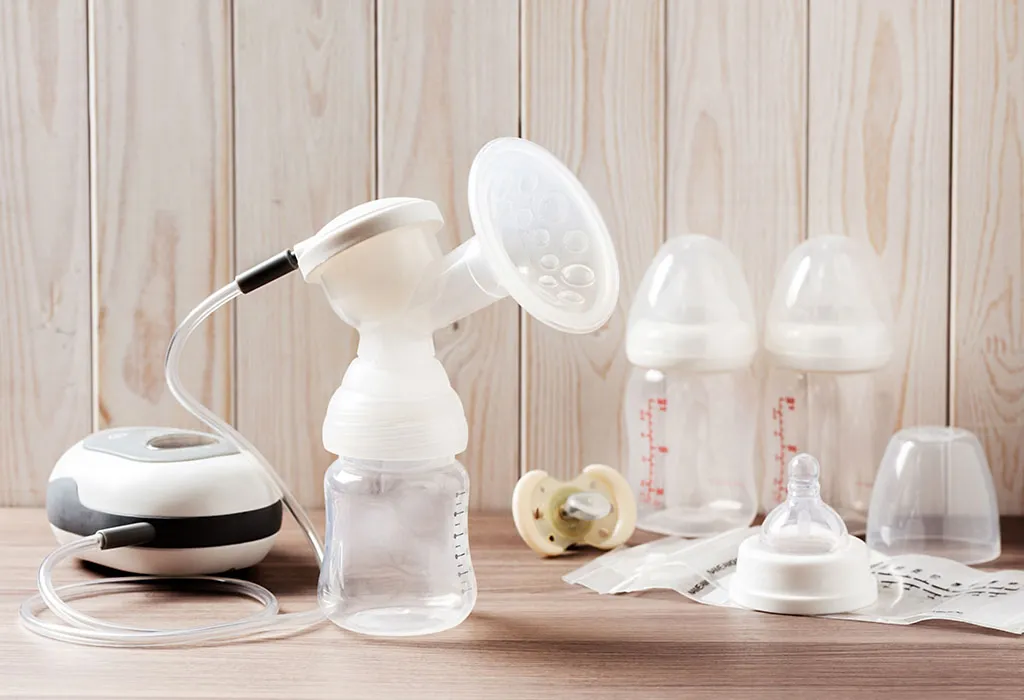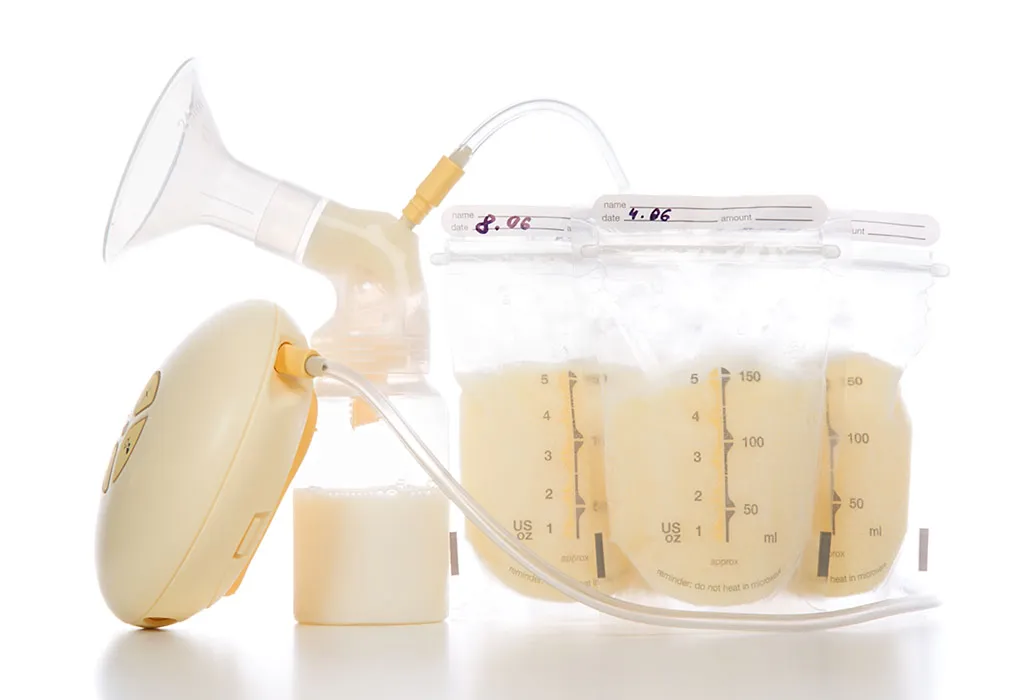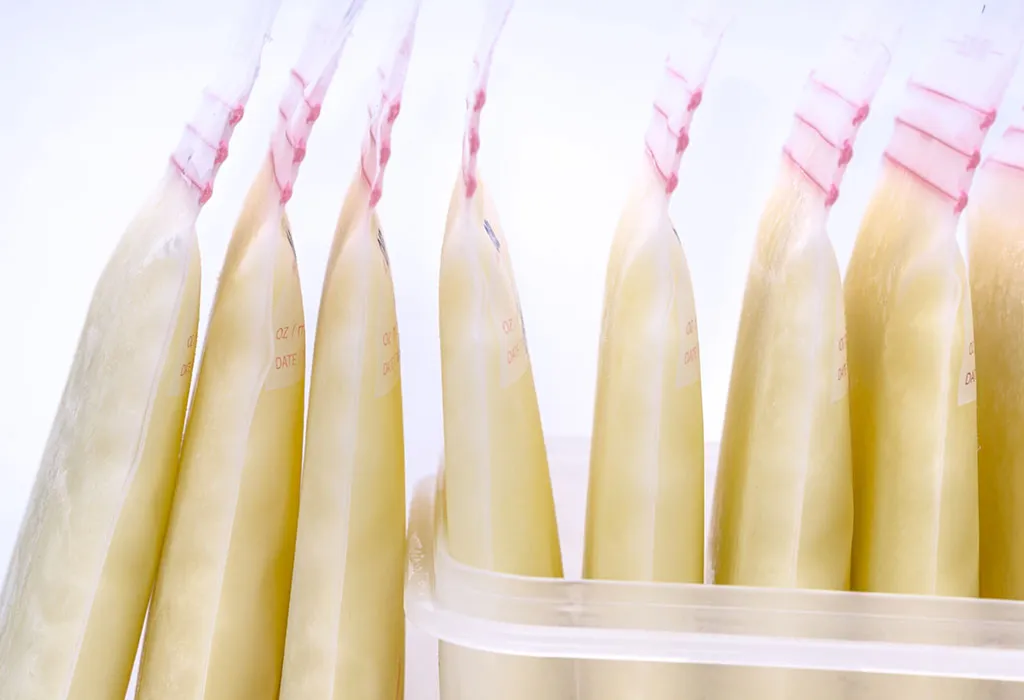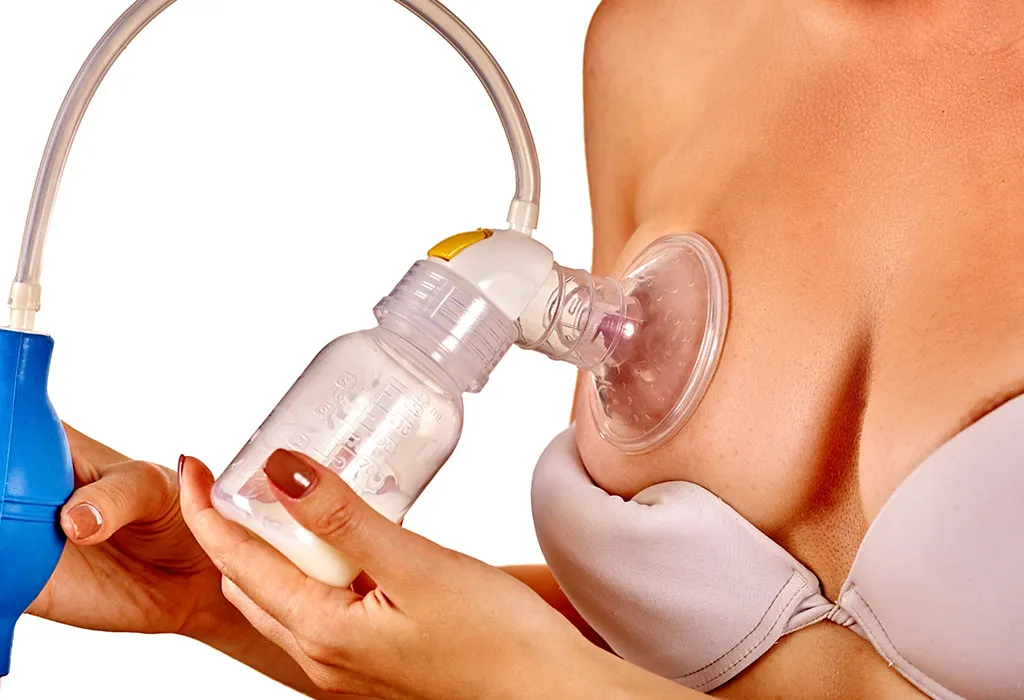How to Pump & Store Breast Milk
- Why Do You Need to Pump the Breast Milk?
- What Is a Breast Pump?
- What Is a Breast Pump Used for?
- Why Is a Breast Pump Used?
- What Are the Different Types of Breast Pumps?
- When Can You Start Using a Breast Pump?
- How Do You Choose a Breast Pump?
- How to Use a Breast Pump
- When to Express Breast Milk by Hand and How Do You Do It?
- How Much Breast Milk to Pump
- How to Store Breast Milk
- Where to Store Breast Milk After Pumping
- How to Freeze and Thaw Breast Milk
- Possible Reasons For Why You Are Facing Difficulty Pumping Breast Milk
With mothers becoming increasingly conscious about taking care of their children in every possible way, but without compromising on their careers, one essential in every new mother’s bag is a breast pump. This is also very beneficial for mothers who are suffering from lactation issues or simply want to include their partner and family members in the process of feeding the baby. Easily available in many different types, breast pumps not only help feed the baby when the mother is not around but have multiple other benefits, too. Read on to learn about the mechanism of a breast pump and how to pump & store breast milk.
Why Do You Need to Pump the Breast Milk?
Reasons for pumping breast milk may vary from individual to individual. You may want to use a breath pump for a variety of reasons (1):
- Pumping breast milk helps increase the breast milk supply when done between or after the breastfeeding session. Pumping also signals the body to produce more breast milk when the supply is low.
- If you are a busy mom and have to be away from your nursing baby for a while, you can store breast milk for your newborn baby so they do not stay hungry (2).
- If your little one has transferred to bottle feeding but your breasts are fully in charge of producing the milk, you can pump the extra milk and donate it to the local milk bank.
- Pumping breast milk helps empty the breasts and helps relieve breast engorgement or mastitis.
- If your baby is premature and unable to latch on your breasts, you can use a breast pump and manually feed them expressed milk.
What Is a Breast Pump?
A breast pump is a machine which mimics the sucking action of a baby to help express breast milk. It consists of a breast phalange or shield that fits over the nipple, a pump that is operated either manually or by electricity, and a bottle where the expressed milk collects.

What Is a Breast Pump Used for?
Used for expressing breast milk, a breast pump is not only essential for mothers who want to return to work or take a break from breastfeeding but also can be used to donate breast milk. It helps maintain or even increase the milk supply (3).
Why Is a Breast Pump Used?
Pumping stimulates the production of milk and is an effective solution for mothers experiencing lactation issues. A breast pump alleviates discomfort caused by engorged breasts, too.
What Are the Different Types of Breast Pumps?
There are several types of breast pumps that cater to the needs of all mothers depending on their requirements with multiple modulations. However, these dominantly fall under two major types. Using the pumps depends on your comfort level and practice. Start at a lower suction rate and gradually increase the setting to match the amount you can pump.
1. Manual Milk Feeding Pump
Using a breast shield to cover your breast, you can express milk from the breast, squeezing the lever to create suction and pump breast milk (4).
2. Electric Pump
This breast pump uses electricity to operate, allowing the mother to continuously use the pump and even adjust the degree of suction (4).
When Can You Start Using a Breast Pump?
You can choose to start using a milk suction pump as soon as your baby is born, on the recommendation of a lactation counsellor or a paediatrician, in case there are any medical issues which are coming in the way of nursing. Premature babies who find it difficult to latch on, multiples, or children with special needs may also necessitate early pumping. However, if nursing is progressing well, doctors may recommend waiting from one to three weeks before introducing the bottle to avoid nipple confusion.
How Do You Choose a Breast Pump?
For smooth and problem-free pumping, you need a pump that is of good quality and works well over time. A manual pump or an electric pump that does not work very well over time can hinder the expression of milk. Using a good hospital-grade breast pump is highly recommended. A hospital-grade, electric, double pump might give you better results.
How to Use a Breast Pump
Getting started with your breast pump is as easy as one-two-three! Simply place the breast shield over your nipple and pump to start expressing. If you are using an electric or a battery-operated pump, this simply involves switching it on, but if you are using a manual pump, you will need to pump it manually.
Tips to Pump Breast Milk
Here are a few tips which will help in preparing to pump breast milk:
- Relax: Finding a quiet spot to relax helps encourage let-downs.
- Massage: A quick breast massage, leaning over to let gravity do its part, or a warm compress to help you start off.
- Invest in a hands-free pumping bra: This bra holds the pump in place, leaving you free to read a book, text or even work on your computer. Some mothers even make their own hands-free bras by cutting holes in an old sports bra or attaching rubber bands to a nursing bra.
- Start at the lowest setting: When using an electric pump, make sure you start at the lowest and increase it gradually as you get comfortable.
Some women, however, may want to or have to express breast milk by hand. Read on to know when and how you can do it.
When to Express Breast Milk by Hand and How Do You Do It?
If you prefer to nurse your baby and only occasionally feel the need to express milk, pumping breast milk by hand may be the right option for you. Here is how to do it (5):
- Wash your hands: Babies are sensitive, and it is important to maintain hygiene at all times.
- Massage: A gentle breast massage or a warm towel helps stimulate let-downs, making it easier to express milk. You could even lean forward to let gravity help.
- Getting the right position: Using your thumb and index finger, form a C about an inch behind your areola.
- Express: Press your fingers towards your chest wall and use a gently rolling motion to express milk.
- Storing: Collect the expressed milk in a clean bottle for storing.
How Much Breast Milk to Pump
How much you pump mainly depends on how much your little one consumes or how much you want to donate. It is not always necessary to pump in excess, so don’t get unduly worried if you are unable to pump in large quantities (3).
- There is no set rule about how often you should pump breast milk. Pumping breast milk primarily depends on how old your baby is. Over a period of time, the amount of milk you can pump gradually increases.
- How much you wish to pump also depends on how your breasts feel after you have pumped.
- How much you need to pump will also depend on how big your milk-making glands are. Remember that the size of your glands is different from the size of your breasts.
- A good pump can pump both breasts in about 10 to 15 minutes.
- With continuous practice, you will be able to pump more milk as your breasts get adjusted to the pump, which will give you quality milk.
- Keep a significant time difference between two pumping sessions to ensure that you get similar quantities of milk. When you are at work, you can pump every 3 to 4 hours for about 15 minutes on each breast.
- It is important to know how many times your baby passes urine in 24 hours.

There is no single rule about how much breast milk to pump. So, pump your breast milk at your own convenience and according to your baby’s needs. Nobody knows your body better than you do.
How to Store Breast Milk
There is no single rule about how much breast milk to pump. So, pump your breast milk at your own convenience and according to your baby’s needs. Nobody knows your body better than you do. Here are some tips for storing breast milk according to the Mayo Clinic (6):
- You can store breast milk in airtight, BPA-free plastic containers, milk bags, stainless steel, or glass containers to keep it fresh for a longer period. You can use milk bags to store more quantity in less space.
- Usually, the pump comes with a storage container with a measurement scale, allowing you to store milk according to your baby’s consumption.
- The milk can be stored in the freezer for a certain duration depending on the temperature, although it is better to make sure the baby consumes the milk in the earlier periods since, with time, its nutritional value diminishes.
- Do not use plastic bags or disposable bottle liners regularly used for general household use to store the pumped breast milk.
Where to Store Breast Milk After Pumping
Pumping milk from breasts becomes a relief when you know that there is stored milk in your freezer. You do not have to keep undergoing the process every time. The milk can be stored for 4 hours to 90 days or more, depending on the climatic conditions of the place where you live. However, keep the following pointers in mind when you are storing it.
How to Freeze and Thaw Breast Milk
Time is a major constraint in freezing and thawing breast milk. If the thawed milk is not consumed within 24 hours of refrigerating or after 1 hour at room temperature, it will spoil. A disadvantage of thawed milk is that it cannot be frozen again. The following should help you keep your milk fresh and in good quality.
1. Freezing Breast Milk
While freezing, remember to keep it in containers according to the portion suitable for your baby. If 50 ml is consumed per intake, store it accordingly. This helps you to make sure that you do not waste milk.
Do not freeze it in containers from which you cannot dispose of it easily. This not only increases the hassle but also allows impurities to seep in. Store and freeze the breast milk in small batches and label each of them when they are expressed (7).

2. Thawing Breast Milk
Always remember that the milk needs to be thawed and not boiled or microwaved. Hold the container with the milk in it under warm water until it reaches a suitable temperature.
You can also let it defrost in the main compartment overnight and use it at room temperature the next day.
Do not use the microwave for defrosting or warming, as it kills the nutrients in the milk. Hot spots may also develop, decreasing the quality of the milk.
According to the CDC, breast milk can be stored on the counter after it is thawed for one to two hours, up to 24 hours in the refrigerator. But never refreeze the breast milk after you have thawed it, even once (8).
3. Storing Breast Milk
If you are storing the milk in the freezer section of your refrigerator, it will stay fresh for a maximum of two weeks. The sooner you can use this milk, the better it is.
Some refrigerators have a separate compartment as a freezer. As this is opened less frequently, and at 0⁰ F, it keeps the milk fresh for three to six months.
Deep freezers, comparatively, keep the milk fresh the longest. It can be preserved for a maximum of twelve months.
However, if you like the milk to be fresh and consumed within a day, the Centre for Disease Control and Prevention (CDC) suggests that the best way to store breastmilk is at room temperature for six to eight hours. Maximum 12 hours is acceptable (9).
Although pumping breast milk may seem easy, several mothers might face difficulties while expressing milk. Read on to know more.
Possible Reasons For Why You Are Facing Difficulty Pumping Breast Milk
Pumping breast milk takes a little bit of patience and a little bit of time. Adjusting your schedule to accommodate it might create issues sometimes as you might not always be able to find time to pump when you lactate. However, once you get the hang of the lactation time periods, you can conveniently pump milk, keeping the following factors in mind, which might also create difficulty while pumping.
1. A Fussy Baby
It is important for you to be relaxed for a let-down to take place. If your baby is fussing, you may not be able to pump effectively.
2. If Your Little One has Just Finished Feeding
This is not the best time to prepare a new batch. Give your body some time. Relax a little, and eventually start pumping. Remember, there is no rush. Your baby and your breasts understand when to accommodate each other.
3. Not Knowing the Rate of How Fast or Slow You Must Pump
If you try to pump at a faster rate, the chances are that you will not be able to pump any milk at all. At the same time, pumping at a slower rate won’t create enough suction.
4. Inappropriate Size of the Breast Shields
The right-sized shield is important for successful pumping. Using an inappropriate size might cause your nipples to swell up when you start the pump. In this case, the quantity of milk expressed might not be a lot, and you may also end up with pain in the breast region.

5. Scant Lactation
Keep your body hydrated at all times. Frequent breastfeeding and pumping can help resolve the issue by preventing the milk from drying up and increasing the flow of breast milk.
6. Stress
During the pumping process, it is very important for you to be relaxed. If you and your body aren’t relaxed, you will not get sufficient results at the end of it. If you still have difficulties, gently massage your breasts and use warm compresses on them before pumping. Be comfortable, close your eyes, and go to your happy place while pumping.
Pumping breast milk is rapidly catching up among new-age mums as it lets you fulfil your baby’s needs while also bringing you convenience. Attaching a machine to your breasts might be scary as it is a relatively new idea, but with the conventional methods that are coming up, mums around the globe are readily accepting this. When in doubt, talk to a lactation counsellor or other women who are aware of various breastfeeding methods and seek help. Sometimes, talking to others who are on the same journey might give you deeper insights into catering to the needs of your baby.
Also, remember that when it comes to the well-being of your baby, multiple factors may come into play. What to expect in the process of child-rearing becomes the priority of every parent. Fathers, too, play an active role in it. Breast pumps help ensure that feeding is not only a mother’s job, but the father can pitch in to help, too.
References/Resources:
1. Enger. L, et al.; Patient education: Pumping breast milk (Beyond the Basics); UpToDate; https://www.uptodate.com/contents/pumping-breast-milk-beyond-the-basics/print; May 2023
2. Pumping and storing breastmilk; https://womenshealth.gov/breastfeeding/pumping-and-storing-breastmilk
3. Breastfeeding: How to Pump and Store Your Breast Milk; Familydoctor.org; https://familydoctor.org/breastfeeding-how-to-pump-and-store-your-breast-milk/
4. Breastfeeding FAQs: Pumping; Nemours KidsHealth; https://kidshealth.org/en/parents/breastfeed-pump.html
5. Expressing by hand; NHS; https://www.nhs.uk/start-for-life/baby/feeding-your-baby/breastfeeding/expressing-your-breast-milk/expressing-breast-milk-by-hand/
6. Breast milk storage: Do’s and don’ts; Mayo Clinic; https://www.mayoclinic.org/healthy-lifestyle/infant-and-toddler-health/in-depth/breast-milk-storage/art-20046350
7. Tips for Freezing & Refrigerating Breast Milk; American Academy of Pediatrics; https://www.healthychildren.org/English/ages-stages/baby/breastfeeding/Pages/Storing-and-Preparing-Expressed-Breast-Milk.aspx
8. Storage and Preparation of Breast Milk; CDC; https://www.cdc.gov/breastfeeding/pdf/preparation-of-breast-milk_h.pdf
9. Breast Milk Storage and Preparation; CDC; https://www.cdc.gov/breastfeeding/breast-milk-preparation-and-storage/handling-breastmilk.html
Also Read:
Breast Milk Storage After Pumping
Tips to Make Breast Pumping at Work Easier
Most Common Breastfeeding Problems & Their Solutions
Must-have Pumping Essentials for Breastfeeding Moms
Was This Article Helpful?
Parenting is a huge responsibility, for you as a caregiver, but also for us as a parenting content platform. We understand that and take our responsibility of creating credible content seriously. FirstCry Parenting articles are written and published only after extensive research using factually sound references to deliver quality content that is accurate, validated by experts, and completely reliable. To understand how we go about creating content that is credible, read our editorial policy here.























